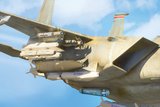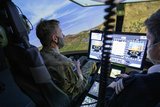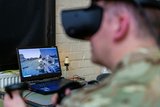Riding the Data Wave: How the Military is Harnessing the Power of Data Integration (Studio)
Brought to you in partnership with BAE Systems
Digital innovation is sweeping over the military landscape. It is revolutionising the technologies we use and the ways we develop them.
Conflict today is about much more than the battlefield. The ability to integrate, analyse and control data is critical.
Iain Minton, Technology Capability Delivery Director at BAE Systems Air, paints a picture of a “blurring” between different platforms, all part of the evolution of multi-domain operations.
In this new era, systems don’t just coexist; they’re increasingly intertwined, forming an interconnected web of military prowess.
The multi-domain network must be interoperable and data-driven to be effective and to achieve this, it must use the best technology available.
‘The key is not just the technologies we develop, but working in a faster and more agile way,’ Minton says. ‘We do that by working with our partners and customers to ensure we deliver the technologies they need and that those technologies can interface and connect across platforms and across domains.’
Data: The New Battlefield
It’s not just about military platforms delivering kinetic effects anymore; it’s about data. We’re living in an information age, one that’s swelling with each new sensor we deploy.
Data is also the key pillar of multi-domain operations, the central focus of Western military planners for the future battlespace. Land, sea and air will increasingly come together and need to talk to one another. On top of that, they also must integrate with the emerging space and cyber domains.
The crux of the digital puzzle? Mastering data, moulding it into the precise information our troops need, delivered exactly when they need it.
‘It’s about how you understand data, how you manage it, how you give them the right information so they can make the right action at the right time’ Minton explains.
This data deluge brings two key demands. First, militaries must generate the data they need. And second, they must be able to understand the information they possess.
This will require new skills across militaries, with an increasing emphasis on data specialists. Minton argues that it will also demand advances in processes and development for industry leaders.
‘Things are speeding up – how do we understand the pace? How do we keep ahead of it? How do we ensure we’re investing time and effort at the early stage, in the scientific area, to deliver what the customer needs? That’s a key element.’
This data revolution stimulates numerous demands, but Minton identifies two key aspects.
‘First, what does a person need when they are in the conflict area, and how do you give them that information? Second, how do we provide the solution and give them the tools they need? So it’s not just a matter of delivering them the information but providing that filtering to give them what they need to know.’
Embracing AI and Simulation
In this quest for technological superiority, trust and comprehension are paramount. Emerging technologies such as artificial intelligence (AI) need to integrate and operate as valuable allies.
Minton says the company’s deep understanding of game-changing technologies such as AI enables it to discern strategic investment areas, prioritising technologies that operators can trust and rely on in critical situations to give them an advantage.
He also highlights the significance of advances in computer simulation technology, enhancing the warfighter’s decision-making capabilities in data-rich environments.

Other advances include the rapid development of quantum computing, which could bring significant opportunities in communications and beyond. The human-machine interface is another major focus, particularly for pilots.
Minton notes that BAE Systems has focused on a “wearable cockpit” technology for some years, utilising the power of its Striker II helmet-mounted display through eye-tracking technology, for instance. Other examples could include using technology such as haptic gloves, he adds.
Such technologies give pilots a vital advantage, delivering major improvements in situational awareness, speed of decision-making and the ability to affordably and rapidly upgrade the cockpit in line with future enhancements.
‘Can I remove the need for a cockpit and have it projected onto the helmet? Can I integrate virtual assistants? Can I use machine learning to process large amounts of data?’
Fostering Industry Collaboration
In today’s intricate and rapidly evolving technological landscape, collaboration is vital.
BAE Systems actively engages with universities and other industry experts, recognising their potential to offer a critical advantage in the company’s pursuit of technological leadership.
For example, Minton points to the company’s work with Williams Advanced Engineering (WAE) on future battery technology, which could one day offer new options for electrification in sixth-generation aircraft such as Tempest, providing direct benefits to the company and its customers.
Next-generation combat air technologies will need high power at low weight in order to provide long-range endurance and mission success. The collaboration with WAE is helping to develop advanced battery technologies that will provide pilots with high-performance ‘power when you need it’ combat air capability.
There are also significant lessons to be learned from other sectors, some of which might not be immediately obvious.
The gaming industry, for instance, holds valuable insights into how to foster disruptive technologies, especially in visualisation and virtual reality (VR) headsets, and how to accelerate the pace of development.
Minton says the company‘s strategic collaborations with startups and various industries, such as gaming and automotive, play a pivotal role in ensuring that its technologies are at the forefront of innovation.
Why does this matter? As the future operating environment becomes increasingly data and technology-driven, the benefit of multi-domain operations will be vital.
BAE System’s role as a Lead System Integrator (LSI) and a multi-domain integrator enables it to weave these innovative technologies seamlessly into the conflict environment.
‘We provide that cohesive, strategic integration that amplifies the power of individual technological solutions. This approach ensures that our customers maintain an edge on the battlefield and empowers them to navigate the future threat landscape confidently,’ Minton concludes.
More from Studio
-
![Combat-proven capabilities: How precision-strike systems are evolving for tomorrow’s battlespace (podcast)]()
Combat-proven capabilities: How precision-strike systems are evolving for tomorrow’s battlespace (podcast)
Combat-tested technology is being reshaped to counter A2/AD threats, reduce reliance on GPS and enable faster, more autonomous targeting in complex environments. In this special podcast, experts explain how the evolving threat landscape is shaping next-generation strike capabilities.
-
![Energy evolution: How laser defence systems are powering the next phase of air defence (podcast)]()
Energy evolution: How laser defence systems are powering the next phase of air defence (podcast)
Laser-based air defence is moving from promise to deployment as global threats evolve. In this special podcast, we explore how high-energy laser systems are reshaping interception strategies.
-
![Intelligence advantage: How real-time GEOINT is reshaping military decision-making (Studio)]()
Intelligence advantage: How real-time GEOINT is reshaping military decision-making (Studio)
In today’s contested operational environment, adaptability is key. The new Geospatial-Intelligence as a Service (GEO IaaS) solution from Fujitsu and MAIAR empowers militaries by enabling intelligence advantage, combining advanced technology with human expertise to deliver actionable insights.
-
![Training Together: Unlocking Educational Excellence through Military and Industry Collaboration (Studio)]()
Training Together: Unlocking Educational Excellence through Military and Industry Collaboration (Studio)
Military training is ultimately about people. At Capita, training programmes are built on close engagement with partners, delivering an educational approach that can adapt to individual needs, cultivate leadership – and drive wider cultural change.
-
![Enhancing Military Training Through Digital Technology (Studio)]()
Enhancing Military Training Through Digital Technology (Studio)
Digital technologies offer huge opportunities for defence training. However, militaries must adopt an agile approach, placing the needs of their organisations and personnel at the centre of their efforts.
-
![Layered Defence: How new technologies are enhancing armoured vehicle survivability and manoeuvrability (Studio)]()
Layered Defence: How new technologies are enhancing armoured vehicle survivability and manoeuvrability (Studio)
As modern threats evolve, armoured fighting vehicles face a new era of challenges, from loitering munitions to kinetic energy projectiles. Advances in active, passive, and reactive protection systems are crucial to ensuring battlefield dominance, freedom of manouver and vehicle survivability.























